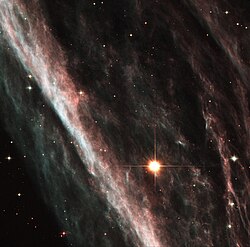| Nebula | |
|---|---|
 Hubble Space Telescope image of NGC 2736 | |
| Observation data: J2000 epoch | |
| Right ascension | 9h 0m 17s [1] |
| Declination | −45° 54′ 57″ [1] |
| Distance | 815 ly |
| Apparent magnitude (V) | +12.0? |
| Apparent dimensions (V) | 30'x7' |
| Constellation | Vela [2] |
| Physical characteristics | |
| Radius | ~5.0 ly |
| Designations | NGC 2736, Pencil Nebula |
NGC 2736 (also known as the Pencil Nebula) is a small part of the Vela Supernova Remnant, located near the Vela Pulsar in the constellation Vela. The nebula's linear appearance triggered its popular name. It resides about 815 light-years (250 parsecs) away from the Solar System. It is thought to be formed from part of the shock wave of the larger Vela Supernova Remnant. The Pencil Nebula is moving at roughly 644,000 kilometres per hour (400,000 miles per hour)
